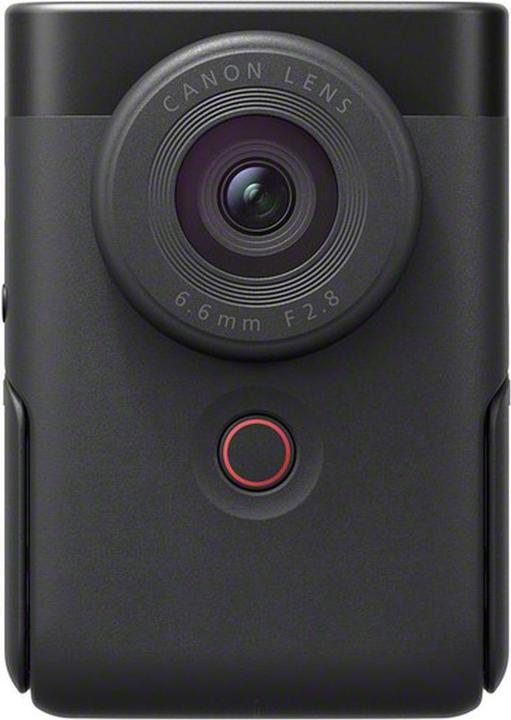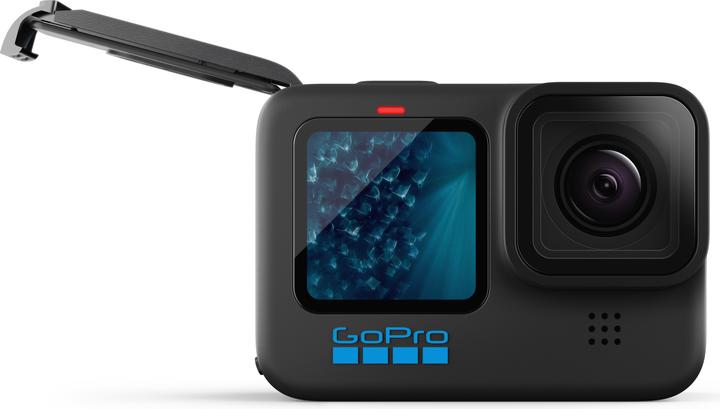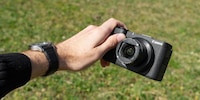

Could Canon and Sony help me become a YouTube star?
It’s time for me to set off on the road to YouTube stardom. Two new vlogging cameras will be guiding me along the way. But which one will win me over? The inexpensive Canon V10 or the pricey Sony ZV-1 II?
Fewer than 20 people have subscribed to my personal YouTube channel. If things go on like this, I’ll never become a real influencer. One promising strategy I could adopt is to create video blogs, also known as vlogs. This would involve me filming myself, my life and my hobbies, and uploading the videos to the net.
One vlog, two vlogging cameras
Rushing out to buy a professional camera with matching lenses is out of the question for a beginner like me. If I did that, it’d set me back thousands of francs, which would be pretty over-the-top given I’ve got fewer than 20 fans. This considered, my camera has to be a cheaper, entry-level model. In recent weeks, Sony and Canon have each unveiled new models. Their central focus? Vlogging. This is essentially means that you can see yourself on a foldable screen while you’re filming, the cameras are compact for on-the-go use, and the controls are simple and suitable for beginners.
I also went ahead and shot a vlog on the two new cameras. It’s important you know that I didn’t make any adjustments to the picture or sound. Basically, what you see here is the RAW version in fully automatic mode, exactly as it comes out of the cameras. The same goes for the microphones too. And spoiler alert: the sound is seriously good!
Let’s start off with a comparative overview of the technical specs:
Canon V10: low price, new concept
There are two immediately striking things about the Canon cam. First off, it costs way less than the Sony model. As of the time of this review, you can easily buy two Canon cameras for the price of one Sony.
Secondly, even though both models were designed as vlogging cameras, they look different. While the Sony looks like a classic compact camera, the Canon is built to sit upright, on its narrower side. This makes it easier to hold the Canon V10 when filming yourself. It also has an integrated flexible stand, eliminating the need for a tripod. You can immediately get started with shooting videos.
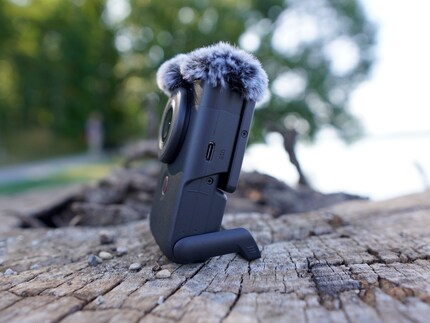
Source: Lorenz Keller
Canon V10: decent quality, fully catered towards vlogging
The strength of Canon’s focus on video blogging is evident as soon as you look at the record button. Positioned on the front (as opposed to on the top or rear), it’s within easy reach when you’re filming yourself. If you’re filming something else, you’ll have to feel for the button (which works well) or start recording via the touchscreen.
The ultra-wide-angle lens is also primarily intended for video selfies. You don’t need to outstretch your arm overly far to get a good shot. Holding it 30 to 40 centimetres in front of your face will do the job.
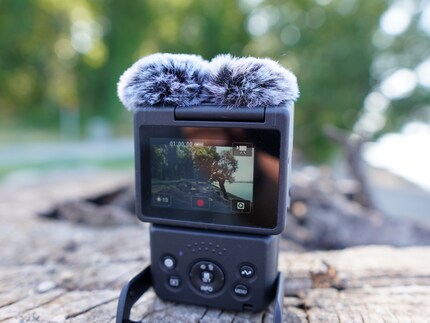
Source: Lorenz Keller
As is to be expected with a very wide-angle lens, the video image is relatively «flat». People are displayed nice and sharply, as is the background. There’s no depth of field, making the look reminiscent of an action cam. As you can see in this sample video, the image quality is decent for a camera of this price, even with backlighting. The Canon has much more trouble with high contrasts and low-light conditions.
The camera’s strengths lie in its simple controls. All you really have to do is decide whether you want to film in 4K or FullHD – and you can hit the ground running. The microphones are excellent – although you’ve the option to connect an external microphone, you don’t have to.
Canon V10: inexplicable weaknesses in the details
Unfortunately, Canon has also built avoidable flaws into the concept. You can get used to the fact that the stand can only be folded away when the screen is slightly open. However, the fact that the wind shield (a must when filming outdoors) covers a third of the screen in selfie mode is a real pain. Not only that, but the two fluffy covers it consists of, can only be attached magnetically. As a result, they fall off every now and again when I’m carrying the camera around.
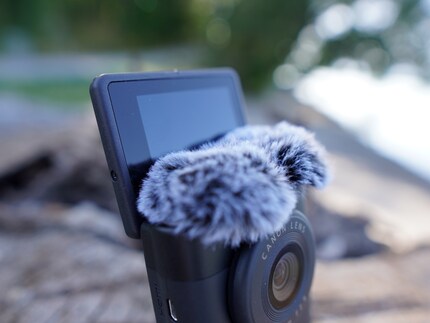
Source: Lorenz Keller
It’s also a shame that despite the microphone input, there’s no mount for external accessories. The battery should manage just under an hour of 4K recordings, but it can’t be removed. Consequently, quickly swapping out the battery isn’t an option. At least you can still use the camera when it’s connected to a power bank or power outlet via USB-C.
On top of that, the V10 creates false expectations. It may look robust, but it’s not protected against water or dust. In fact, the ports are completely exposed. The camera’s shape gives you the impression that you can use it to shoot portrait videos for Instagram or TikTok too. What it actually does, however, is shoot in typical landscape mode. You can only get portrait shots by doing what you’d do with any other camera – flipping it onto its side and rotating the shots later.
At least the V10 can be easily connected with a smartphone app. The app allows you to get photos and videos onto your phone quickly, serves as a remote shutter release, and even enables instant streaming to YouTube and Facebook.
Sony ZV-1 II: decisions, decisions
For beginners, the ZV-1 is significantly more complex than the Canon. This becomes clear as soon as you see the number of controls and the much more complicated menu structure. Mind you, this camera also has a fully automatic mode for beginner users too. And as it works in the same way as a compact camera, it’s easy to get started. Though the ZV-1’s main focus is video too, it’s kitted out with every kind of photo feature and can be used as a great compact camera.
Bear in mind that although you can take handheld selfie videos too, you need to stretch your arm out much further in automatic mode than when using the Canon. I’d definitely recommend using a selfie stick with the Sony so that you can hold it comfortably while keeping it stable.
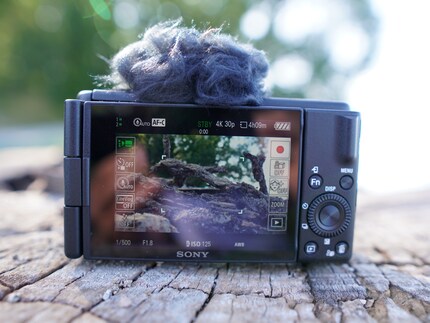
Source: Lorenz Keller
Sony ZV-1 II: professional image quality
The Sony’s major strength is its first-class image quality. Many YouTubers and content creators use the ZV-1 as a second or third camera when they’re out and about, so as not to have to cart around a hefty pro camera. The clips it shoots can be combined with footage from more expensive cameras without issue.
For beginners, the camera’s precise, fast autofocus is worth its weight in gold. Even in automatic mode, the feature ensures you’re always in focus, while some slight blurring around you makes the shots look more professional. At the click of a button, the software allows you to enhance this blur even more. The automatic Product Showcase Set is practical too. If you hold an object in front of the camera, it’ll come into focus immediately. Taking the object away will switch the focus back to your face.
As the far pricier of the two cameras, the Sony also offers a bunch of other features. These include manual settings and even different focal lengths for close-up shots and zoom. The sound is even better than on the Canon, the screen is larger and folds more flexibly, a wireless microphone can be connected directly to the hot shoe... the list goes on.
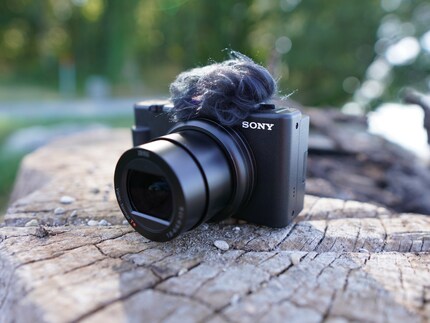
Source: Lorenz Keller
Sony ZV-1 II: previous weaknesses haven’t been corrected
Sony has taken the predecessor model’s micro-USB port and replaced it with a modern USB-C connector. But not all of the previous model’s weaknesses have been straightened out. For instance, offering little over half an hour’s worth of 4K recording, the battery life is pitiful. However, at least you have the option of taking out the battery and grabbing a second one. What’s more, the Sony allows you to record video while using an external power supply.
Annoyingly, although Sony has reduced the focal length from 24 to 18 millimetres, it’s also taken away optical stabilisation. While the wider angle is actually ideal for vlogs, you can only use the smaller focal length without stabilisation. This is ill-advised if you’re filming yourself in vlog-style. If you’re using the electronic stabilisation in automatic mode (like in the example video above), the image is cropped, effectively leaving you with a focal length of around 23 millimetres again. This means you have to hold the camera further away to get a good angle of view.
To top it all off, the Sony’s menu is incredibly confusing and ramified – a complete turn-off for beginners especially.
The verdict: both cameras have tough competition
Neither of the two cameras I tested is ideal for my YouTube career. The Canon PowerShot V10, however, offers good performance in relation to its price. It’s also advantageous in the sense that you can get started right away and that you have everything packed into one device. What’s more, its stabilisation, sound and image quality in good light are impressive. That being said, the V10 is more suited to occasional users with low expectations – people who just want to get stuck in.
Sony delivers better quality across the board. And you’re able to learn and develop along with the camera. Too bad the battery is so poor, and that there’s no stabilisation at a really good wide-angle. If you’re looking to make it big on social media, the Sony is actually the better overall choice.
However, both cameras have serious competition, with the situation proving especially brutal for the second generation ZV-1. You see, the first generation is still available at significantly lower prices. There’s basically no difference between the two in terms of quality, and the optical stabilisation used in the first ZV-1 might even be more appealing to some.
And there’s even more competition lurking in our trouser pockets, as good smartphone cameras can definitely go toe to toe with the V10. Action cams like the similarly priced GoPro Hero11 are also passable. They’re even more portable and robust, though the sound is considerably poorer.
Basically, I haven’t found the ideal camera for my YouTube career just yet. Maybe it’s for the best. That way, I’ll be forced to focus on the content first, not on the tech. In the meantime, you can still like, share and comment on my videos. And don’t forget to subscribe!
Header image: Lorenz Keller
Gadgets are my passion - whether you need them for the home office, for the household, for sport and pleasure or for the smart home. Or, of course, for the big hobby next to the family, namely fishing.
